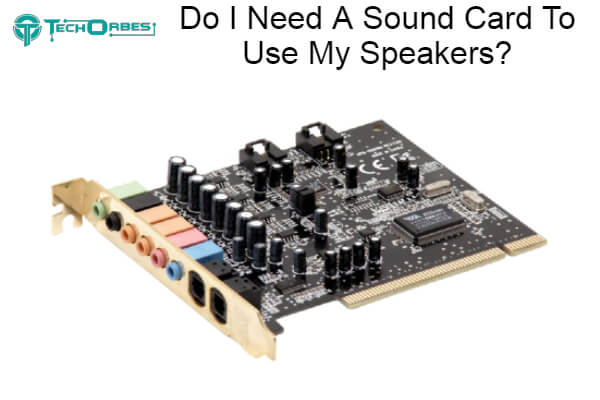Do I Need A Sound Card To Use My Speakers? Quick Brief Guide
This article explains Do I Need A Sound Card To Use My Speakers? A sound card is a part of a computer that converts analog audio signals to digital ones and digital ones to digital ones.
Technically speaking, a sound card is an optional component. Still, it’s essential if you wish to connect an analog microphone or listen to your PC’s audio through wired headphones or speakers (much like an external DAC).
The computer’s CPU is not meant for the particular duty of processing signals into high-quality sound, but these components are made to handle it.
Do I Need A Sound Card To Use My Speakers?
You may be wondering if you need to purchase a sound card if you want to upgrade the audio on your PC or build one from the ground up. Fortunately for you, the day when a PC needed to have this purchase was long ago, but there are still some circumstances in which you might want to consider getting one. Let’s quickly review them.

Do I Need A Sound Card?
No, a typical user won’t need to install a separate sound card on their computer to hear sound. Most computer motherboards come with integrated sound cards that are adequate for most user demands. However, specialized sound cards are still available and could be required in some circumstances for better operation and sound quality.
What Is An Audio Interface?
Although most people now refer to the audio interface and sound card interchangeably, they are essentially two different devices. An audio interface is strictly an external device connected to the host device through cabling, in contrast to a sound card, housed inside the casing of a device, either integrated or through an expansion slot.
By acting as a DAC for audio signals, an audio interface serves the same purpose as a sound card but with the added benefit of supporting more inputs and input types.
Can You Have Audio Without A Sound Card?
Yes, if a speaker with an integrated DAC is linked to your device through a port such as a USB, you can hear the sound without a sound card. However, a sound card of some kind, incorporated, installed as an expansion, or as an external audio interface, is the most efficient way to produce sound on a device.
The process by which an audio signal is comprehended by the computer and turned into an audible signal for the user is accomplished by converting digital signals into analog signals and vice versa, which is the responsibility of the sound card.
How Does A Sound Card Work?
Sound is an analog signal that is produced by vibration. The exact waveform produced by the sound is captured in an analog signal for a sound wave. This waveform changes in voltage, currency, and frequency to depict different sounds.
An analog vibration is conveyed into the inner ear when a human hears a sound, where it is converted to an electrical signal that the brain may interpret as sound. Analog signals are not used to power computers. Computers use digital signals to communicate. A digital signal is a string of 1s and 0s of binary digits that a computer can understand.
By sampling the analog signal at a predetermined rate to create sound, a digital signal is produced. There will always be some small loss when an analog signal is converted to a digital signal, regardless of how sophisticated the digital technology is.
Imagine you are watching your dog catch a ball in this scenario. When you watch the dog catch the ball, you are witness to the entire event. Now picture yourself viewing a video of your dog successfully retrieving a ball. The recording gadget takes several photos of the activity and then compiles them into a movie to create the final product.
But as we all know, instead of being a purely continuous flow like seeing your dog in person, each photo is just one instance of the process. The analog-to-digital conversion follows the same rules.
Playback of the generated video resembles the digital-to-analog conversion process in reverse. All sound samples are combined to produce a continuous analog signal that can be heard through analog speakers and headphones.
Do I Need A Sound Card For Recording?
A microphone of some kind, whether it be an internal microphone or an external mic, is required to record. A microphone records the sound waves a sound generates as an analog signal.
Some microphones additionally include an integrated analog-to-digital converter, eliminating the need for any sound card. The signal must be converted into a format the computer can understand if the microphone does not already have a built-in DAC.
However, generally speaking, the recording does not require a separate sound card. On gadgets like computers, phones, and tablets, the built-in sound cards are capable of recording and often sufficient for the average user.
On the other hand, a specialized sound card or audio interface can be quite helpful if your needs are more sophisticated and call for more accurate audio recording because it enables the generation of clear, high-quality recordings.
Do I Need A Sound Card For Speakers?
Like a microphone, a speaker can be inside the device or external. A transducer, such as a speaker, transforms electrical energy into sonic energy. Some speakers, like USB speakers, don’t need to be connected to a sound card.
The digital electrical signal can be converted into an analog signal that can be reproduced by waves using the integrated DAC in these devices. For usage with speakers that lack an inbuilt DAC, the sound card included in your device can manage the translation of digital sounds to analog.
Although the built-in sound card’s sound quality is adequate for most users, those with more sophisticated speaker systems with amplifiers and numerous speakers for surround sound will benefit from including a separate sound card or an audio interface, depending on the output.
Do I Need A Sound Card For Streaming?
Listening to audio over a network while files are continuously transferred from a server to a client is known as streaming audio. The quality of the sound produced by the onboard sound card is more than capable of producing clear, aesthetically pleasant sounds for the user for the majority of streaming alternatives, such as listening to music on Spotify or Pandora.
Built-in sound cards may produce high-quality sounds without the need for additional hardware and can record sounds from streams that you make yourself. Consider upgrading your external microphone instead of upgrading your sound card if you are a creator of streaming content and need a higher level of audio quality for your recordings.
Does Lossless Audio Require A Sound Card?
Uncompressed, compressed lossless, and reduced lossy audio files are the three basic categories of digital audio files. How the audio file is compressed when it is changed from an analog signal to a digital signal is what distinguishes the three types.
Due to the large size of digital audio files, compression is required. Uncompressed files, which keep all of the audio conversion’s sampling, are commonly found on CDs. When listening to MP3s on smartphone applications, a compressed lossy audio format is typically used.
By removing some frequencies, this form of file minimizes the file size. While doing so, some of the original audio data is also deleted, which increases the file size.
Even though the audio file is compressed, lossless audio files keep all of the audio information, which may be restored by decoding by suitable software. You require an updated sound card beyond the capabilities of the default sound card on the motherboard to fully benefit from lossless audio.
A sound card able to produce these frequencies is necessary since a lossless audio file keeps every frequency produced by the original analog signal. The native sample rate or bit depth of lossless audio files are typically beyond the capabilities of an integrated sound device. Additionally, electrical interference can decrease the sound of your lossless audio file on integrated sound cards.
Conclusion
That’s everything about Do I Need A Sound Card To Use My Speakers? There are numerous justifications for not using a sound card. Like with anything, there are compelling reasons to acquire one as well.
According to my experience, several cards may have EQ characteristics and motherboard audio components that differ from one another. You may continue with the default EQ of a Sound Blaster because you prefer the additional bassy sound it produces.
No action is ever right or wrong. Next, audiophiles will continue to assert their superior knowledge. It doesn’t imply that you should agree with what they have to say. I’d advise giving things a try, seeing what you like, and taking pleasure in the process. It is, after all, your money and ears.
Frequently Asked Questions
Are sound cards still necessary?
Since it was the only method to receive high-quality sound, getting a dedicated sound card for your PC was a given for years. However, the motherboards of contemporary PCs are equipped with high-quality audio hardware. But there are still standalone sound cards.
Can I use a sound card to connect speakers?
You must purchase a stereo 3.5mm/RCA male cable long enough to connect the sub to the sound card. If the distance is great, you can get 3.5mm/RCA female or just some female turn arounds and RCA cable cut to length and from the sub to the speakers, followed by some lovely (monster) speaker cable.
What purpose does a sound card serve?
The word “sound” comes from a sound card’s purpose to improve the listening experience. You are correct that you could hear people better while gaming; however, sound cards also depend on speakers. Most high-end headphones feature a built-in card that those headphones are designed to use.
What can a sound card do?
The sound card is an expansion card that enables the computer to transmit audio data to audio equipment, such as speakers, headphones, etc. A sound card can be used for various things, like hearing video game sounds, listening to music or watching movies, having text read to you, etc.

Since childhood, I’ve been fascinated by computer technology, and have experimented with a variety of hardware and software. It was a dream come true to graduate from a renowned university with a degree in computer engineering, which made it possible for me to pursue my dreams swiftly.
